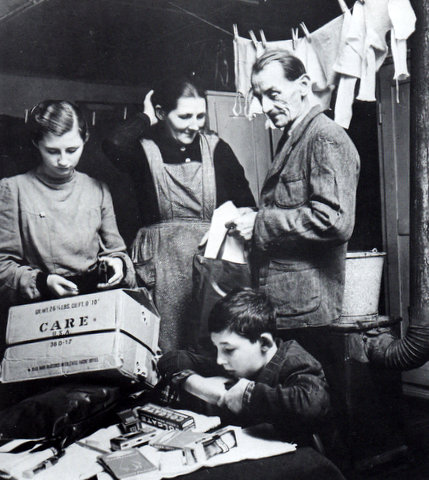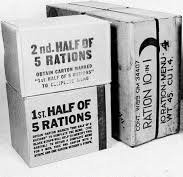How two A-bombs helped feed Occupied Germany - 1946-47
Mar 23, 2015 00:05:50 #
In early 1945, a bloody invasion of Japan seemed inevitable. General MacArther requested huge troop reinforcements in preparation for a D-Day scale operation bigger than anything seen in the Pacific Theater. A lot more GI food was ordered.
The Army's Quartermaster Corps were responsible for supplying it. They developed a compact package called a "10-in-1" group field ration -- a combination of various canned and packaged food items in two cardboard boxes strapped together with metal bands. It weighed about 20 pounds and contained enough food for one varied meal for ten soldiers (six different meat types. liquid and powdered milk, etc., plus cigarettes). The average price per ration was 85 cents.
More than 300 million "10-in-1" rations were produced by 1945, mountains of which were warehoused in preparation for the giant invasion of Japan -- which never came.
Two atomic bombs in August, 1945, brought World War II to a screeching halt and made those mountains of 10-in-1 rations surplus. They sat in warehouses while much of Europe starved at the war's end. The Army's reaction: Not our problem.
The official U.S. attitude toward the German population in the American Occupation Zone was punitive, as ordered by the JCS 1067 Directive's mandates. They were based on the "mass guilt" concept which supported near-starvation of the entire German people. At first they were rationed a maximum of 1,550 calories per person (if they could find them), which was soon reduced to 1,275 calories, and then cut again.
But General Clay began to worry in 1946, because the Russians were providing more food to the Communist Germans. U.S. promises of extra food shipments were often broken, damaging Military Government's credibility. Political unrest was a real possibility.
Meanwhile, refugees ("D.P."s) in the Allied Zones were receiving American food assistance. A major civilian partner in those programs was the humanitarian organization CARE (Cooperative for American Remittances to Europe). They won permission to mail Army surplus 10-in-1 food parcels direct to European individuals.
The costs of the program were covered by having American citizens contribute ten dollars (later fifteen dollars) for each package they ordered. The sender provided the name and last known address of the recipient, and CARE handled the mailing and delivery of the 10-in-1 package. They even traced the recipient if they had moved, thus becoming a missing-person service for the sender. The first 20,000 packages to France arrived on May 11, 1946, a year after the Nazis surrendered.
On June 21, the first CARE packages arrived in the British Occupation Zone of Germany. The American Zone lifted its ban on CARE packages on June 5, 1946. The French allowed shipments into their Zone in December, 1946. The Russians wanted no part in the program.
By the end of 1946, CARE had shipped 550,000 10-in-1 food packages to private addresses in Occupied Germany. The supply of 10-in-1 surplus GI rations finally ran out in early 1947, by which time CARE was creating its own packages. The program was phased out in the 1960s.
The Army's Quartermaster Corps were responsible for supplying it. They developed a compact package called a "10-in-1" group field ration -- a combination of various canned and packaged food items in two cardboard boxes strapped together with metal bands. It weighed about 20 pounds and contained enough food for one varied meal for ten soldiers (six different meat types. liquid and powdered milk, etc., plus cigarettes). The average price per ration was 85 cents.
More than 300 million "10-in-1" rations were produced by 1945, mountains of which were warehoused in preparation for the giant invasion of Japan -- which never came.
Two atomic bombs in August, 1945, brought World War II to a screeching halt and made those mountains of 10-in-1 rations surplus. They sat in warehouses while much of Europe starved at the war's end. The Army's reaction: Not our problem.
The official U.S. attitude toward the German population in the American Occupation Zone was punitive, as ordered by the JCS 1067 Directive's mandates. They were based on the "mass guilt" concept which supported near-starvation of the entire German people. At first they were rationed a maximum of 1,550 calories per person (if they could find them), which was soon reduced to 1,275 calories, and then cut again.
But General Clay began to worry in 1946, because the Russians were providing more food to the Communist Germans. U.S. promises of extra food shipments were often broken, damaging Military Government's credibility. Political unrest was a real possibility.
Meanwhile, refugees ("D.P."s) in the Allied Zones were receiving American food assistance. A major civilian partner in those programs was the humanitarian organization CARE (Cooperative for American Remittances to Europe). They won permission to mail Army surplus 10-in-1 food parcels direct to European individuals.
The costs of the program were covered by having American citizens contribute ten dollars (later fifteen dollars) for each package they ordered. The sender provided the name and last known address of the recipient, and CARE handled the mailing and delivery of the 10-in-1 package. They even traced the recipient if they had moved, thus becoming a missing-person service for the sender. The first 20,000 packages to France arrived on May 11, 1946, a year after the Nazis surrendered.
On June 21, the first CARE packages arrived in the British Occupation Zone of Germany. The American Zone lifted its ban on CARE packages on June 5, 1946. The French allowed shipments into their Zone in December, 1946. The Russians wanted no part in the program.
By the end of 1946, CARE had shipped 550,000 10-in-1 food packages to private addresses in Occupied Germany. The supply of 10-in-1 surplus GI rations finally ran out in early 1947, by which time CARE was creating its own packages. The program was phased out in the 1960s.
GI delicacies sent by a U.S. relative in 1946

10-in-1 rations had one box of "wet" foods, one of dry packages

Mar 23, 2015 00:35:21 #
Mar 23, 2015 00:35:27 #
Mar 23, 2015 06:05:45 #
Mar 24, 2015 06:05:57 #
Mar 24, 2015 08:47:21 #
Mar 24, 2015 16:54:37 #
Mar 26, 2015 21:04:19 #
Your narratives and connected images are always so interesting to me,Richard, certainly history that I was not aware. I found the history of CARE packages interesting as we still use the title for donated help gifts. Thank you for posting. :-)
Apr 6, 2015 17:40:14 #
carlysue wrote:
Your narratives and connected images are always so interesting to me,Richard, certainly history that I was not aware. I found the history of CARE packages interesting as we still use the title for donated help gifts. Thank you for posting. :-)
Thank you, Carlysue. I've been in hospital from Feb. 28 to March 21, recovering from a TSA mini-stroke, so I've been unable to respond to folks who took the time to comment on this posting. However, I intend to resume my postings, and I hope you'll continue to find them interesting.
If you want to reply, then register here. Registration is free and your account is created instantly, so you can post right away.






